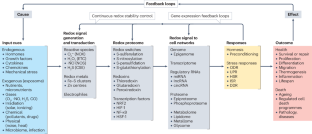生物学中的氧化还原调节基础
IF 81.3
1区 生物学
Q1 CELL BIOLOGY
引用次数: 0
摘要
氧化还原(氧化还原)反应是生命存在的核心。氧、氮和硫的反应物介导了一系列重要细胞过程的氧化还原控制。然而,过量的氧化剂与衰老和许多疾病有关,包括心脏病、神经退行性疾病和癌症。因此,保持活性物种产生和清除的微调稳态平衡至关重要。在此,我们将讨论有关动态维持氧化还原平衡(即氧化还原顺态动力学)和生物氧化还原组织原理(称为 "氧化还原代码")的新见解。我们探讨了氧化还原变化如何通过激素作用机制导致应激反应,以及被称为 "暴露体 "的环境因子的终生累积暴露如何通过氧化还原信号传递给细胞。更好地理解氧化还原生物学的分子和细胞基础将指导新型氧化还原医学方法,以预防和治疗与氧化还原调节紊乱相关的疾病。本文章由计算机程序翻译,如有差异,请以英文原文为准。


Fundamentals of redox regulation in biology
Oxidation–reduction (redox) reactions are central to the existence of life. Reactive species of oxygen, nitrogen and sulfur mediate redox control of a wide range of essential cellular processes. Yet, excessive levels of oxidants are associated with ageing and many diseases, including cardiological and neurodegenerative diseases, and cancer. Hence, maintaining the fine-tuned steady-state balance of reactive species production and removal is essential. Here, we discuss new insights into the dynamic maintenance of redox homeostasis (that is, redox homeodynamics) and the principles underlying biological redox organization, termed the ‘redox code’. We survey how redox changes result in stress responses by hormesis mechanisms, and how the lifelong cumulative exposure to environmental agents, termed the ‘exposome’, is communicated to cells through redox signals. Better understanding of the molecular and cellular basis of redox biology will guide novel redox medicine approaches aimed at preventing and treating diseases associated with disturbed redox regulation. Oxidation–reduction (redox) reactions involving reactive oxygen, nitrogen and sulfur species are vital for life, but excessive oxidant levels contribute to ageing and diseases. This Review explores cellular dynamics of redox homeostasis, such as responses to oxidative and reductive stresses and intracellular and intercellular redox communication pathways.
求助全文
通过发布文献求助,成功后即可免费获取论文全文。
去求助
来源期刊
CiteScore
173.60
自引率
0.50%
发文量
118
审稿时长
6-12 weeks
期刊介绍:
Nature Reviews Molecular Cell Biology is a prestigious journal that aims to be the primary source of reviews and commentaries for the scientific communities it serves. The journal strives to publish articles that are authoritative, accessible, and enriched with easily understandable figures, tables, and other display items. The goal is to provide an unparalleled service to authors, referees, and readers, and the journal works diligently to maximize the usefulness and impact of each article. Nature Reviews Molecular Cell Biology publishes a variety of article types, including Reviews, Perspectives, Comments, and Research Highlights, all of which are relevant to molecular and cell biologists. The journal's broad scope ensures that the articles it publishes reach the widest possible audience.

 求助内容:
求助内容: 应助结果提醒方式:
应助结果提醒方式:


